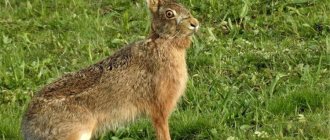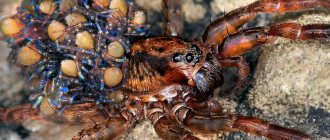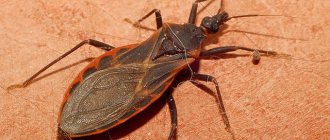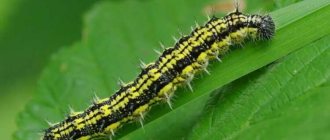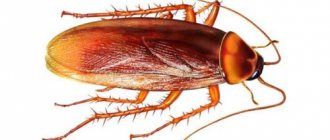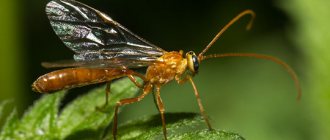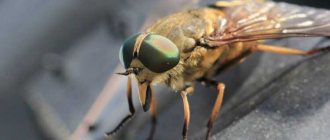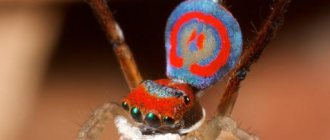Spiders belong to the order of arthropods and are animals, not insects, as many mistakenly believe. By nature they are predators and feed mainly on midges, mosquitoes, flies, etc. But some species do not disdain small rodents and birds.
Not all spiders in Russia are dangerous to humans, despite the fact that they produce and emit toxic substances. More than 32 families of predators can be found on the territory of the Russian Federation. Most of them do not pose a threat, but there are species that you need to be careful of. Let's look at the list of the most interesting representatives living in Russia.
Safe types
Arachnid predators prefer to hunt insects, waiting until the prey gets caught in the net or there is a chance to attack the prey directly. The bites of the predators described below do not pose a serious danger to humans. They can be found both on the street and in residential buildings.
Spiders safe for humans:
Let's look at each type in more detail.
House spiders
The scientific name of the species is Tegenaria agrestis spider . Predators prefer to settle in residential premises and outbuildings. The house spider's main food source is moths, mosquitoes, cockroaches and other small insects.
In an apartment, it hides in cracks between walls, under window sills and baseboards. Natural cover in nature is thick grass and woody remains. The habitat of representatives of this species is from western Siberia to the Crimea. They can also be found in European countries.
The spider's body is dark in color with a yellowish tint. On the back you can see the original brown pattern. The male has a length of about 0.7 cm, while the female is noticeably larger - about 1.2 cm. The legs of the predator are almost twice as long as the body.
The spider weaves a funnel-shaped web, preferring windows and corners near the ceiling. The predator always waits for prey in the center of its network. When the victim gets into it, he moves towards her with lightning speed and injects deadly poison.
Knitters
The common name of the species is Tetragnathidae . The forest spider is notable primarily for its long legs, which are almost 10 times the size of the body. The latter has an oblong shape and a dark color, while the remaining parts of the predator received a pronounced yellow color.
Females are noticeably larger than males, and their abdomen reaches a length of 3 cm. The elongated body acts as a defense mechanism. When danger approaches, the spider presses itself to the surface and looks more like a dry twig rather than an arthropod predator. If it is disturbed, it detaches from the surface, falls to the ground and quickly retreats to a safe place.
The spider weaves extensive webs and moves quite briskly along them using its long legs. Victims caught in the web are immediately immobilized by the poison. The predator releases illiquid insects by gnawing off part of the net.
Orb weaver
The scientific name of the individual is Araneidae . The spider prefers to live in the crowns of standing and fallen trees, placing its webs between the branches. The externally attractive wheel-shaped web has ideal shapes and immediately distinguishes representatives of this species from others.
The poison of the orb weaver is lethal to insects and small vertebrates. It can cause serious harm or even kill small rodents. Cats, dogs, horses and other large animals no longer react to it.
For example, after being bitten by a spider, a frog stops moving after 15 minutes, and a locust dies after half an hour. While a person experiences only a faint echo of pain, even with copious injections of poison. The most you can count on is an extensive allergic rash in people with a weak immune system.
Spiders of this species are characterized by increased gluttony. During one hunting cycle, they can eat up to 8-10 flies or mosquitoes. If there is an illiquid victim in the nets, then the predator simply cuts off the nets and it falls to the ground. In a similar way, the spider cleans the web from the remnants of feasts.
Argiopes
The common name of the species is Argiope . The spider attracts primarily with its original appearance. The predator has a bright color of black and yellow stripes, which makes it look like a wasp. Short hair can be seen on the head and chest. Females are 5-6 times larger than males and can reach a length of 3 cm. The long legs consist of a large number of jointed areas.
The habitat of agriope is central Russia. They are also found in other areas with a temperate climate, most often in the Stavropol Territory. The spider bite is very stinging and the pain is comparable to that of a bee. Argiopes prefer to exist alone and approach their compatriots only to mate.
A predator will never be the first to attack a person unless the latter shows obvious aggression. A small allergic rash appears at the site of the bite, which is accompanied by mild pain. The swelling goes away in about 2-3 days.
Chiroptera
Dwarf pipistrelle , a bat from the smooth-nosed family, is listed in the Red Book. Small in size, from 4.8 to 5 cm, painted in dark sand colors with a brown tint. Found in the southern regions of the region (KK).
Pointed-eared bat . A bat from the smooth-nosed family. Endangered species, listed in the Red Book. The bat is larger than other members of the family. The length of its forearms is about 6 cm. It is colored in dark brown and gray-brown colors (KK).
Common longwing . The bat is small in size, from 5.5 to 6 cm. Its fur is dark in color, from gray-brown to dark brown. Lives in the foothills. On the verge of extinction (KK).
Dangerous species
Dangerous spiders in Russia are noticeably less common than harmless species. They release strong toxic types of substances when they bite, which can lead to paralysis and even death. You need to know such spiders, as they say, by sight and beware of them.
- crosses;
- chiracantids;
- karakurts;
- South Russian tarantula.
Let's take a closer look at them.
Crosses
Scientifically they are called Araneus . The main diet of the cross consists of small insects: butterflies, flies, mosquitoes and others. The spider weaves an extensive web in a very fine mesh. The victim caught in it is immediately immobilized by the poison and becomes entangled. Through the introduction of enzymes, which resemble acid in their properties, the prey becomes a semi-liquid state.
After some time, the predator begins the meal, eating the resulting gruel. If the catch is rich, then the spider leaves the insects for later, attaching them to the edge of the web. For lack of prey, the spider increases the area of the web or moves to another place.
The dimensions of the cross cannot be called large. The length of the abdomen of the male does not exceed 11 mm, and that of the female – 25 mm. The spider can be found throughout the Russian Federation. The highest density was recorded in the thickets of spruce and pine forests. With rare exceptions, the predator can be found in fields, swamps and fruit trees.
It is not so difficult to distinguish the cross from other representatives of arthropods. On his back there is a pronounced pattern resembling a cross. The spider's body is covered with a waxy layer, which helps retain moisture on hot summer days.
On the head of the predator you can see 4 paired eyes. The chest is protected by a durable chitinous covering. The rear part of the abdomen includes several pairs of arachnoid warts, each of which has a mass of small holes. The saturation of color largely depends on external lighting. As a rule, it is a light gray color, sometimes with a reddish tint.
The red blood cells of horses, dogs and sheep are resistant to spider venom, while it can cause serious harm to humans, especially to people with weak immune systems. No deaths were recorded, but in advanced cases necrosis of soft tissues develops at the site of the bite. The latter is quite painful and can cause fever and anaphylactic shock in allergy sufferers.
Hyracantidae
The common name of the species is Cheiracanthium . The spider's habitat is central Russia. The predator prefers to hunt in grass thickets and bushes. Representatives of this species have a wandering lifestyle, that is, they do not weave webs.
Individuals are most active in the dark. For hunting, the spider uses a sand or earthen bank, burrowing slightly into it. The victim touching the chiracantid is immediately bitten and paralyzed, after which the predator calmly eats its meal.
Features
Spiders have eight legs, unlike insects. The forelimbs are equipped with chelicerae, which are poisonous claws. Spider warts are usually located on the lower part of the body, usually in 3 pairs. Some insects also spin webs, for example, caterpillars, but the web of spiders does not break under the force of prey, because it is elastic. There are pairs of eyes located on the head, their number is often 8 or 6, occasionally 2 are found.
Digestion is of the extraintestinal type. For example, a praying mantis chews its caught prey, but spiders inject liquefying enzymes into the carcass. Once softened, they suck out the insides. Arthropods do not attack people or animals first; they bite only if they sense danger. If a spider falls on a person, it should be blown away, but not hit.
Males have bulbs on their limbs in front, which contain sperm for fertilization. Some males run away after mating and save their lives, others agree with the fate of the victim and allow themselves to be eaten. Compared to females, males live short lives. Spiders are caring mothers; they weave small cocoons in the shape of a ball to nurse their babies.
Far East
Among the common spiders of the Far East, two other species of atipus stand out. This family of digger spiders is small and has only 32 species. There are only 4 species in Russia. In the Far East, 2 out of 4 species of atipus live. The animals are not dangerous to humans, but due to their long chelicerae they can inflict a painful bite.
Arthropods are not aggressive individually, but they live in colonies and attack if the family is threatened. If only one individual is in danger, the animal folds its paws and pretends to be dead.
Safe types
Safe species of spiders in Russia hunt insects, waiting for a long time for prey to fall into the net. Their bites are not dangerous for humans. These species live not only in nature; many live in courtyards and settle next to people in their homes.
Safe types of spiders in Russia include the following varieties:
People do not like spiders because in their homes they weave webs into hidden and visible areas of walls and ceilings. But in nature, creatures are beneficial and maintain the natural balance, so there is no need to fight them.
House spiders
This species prefers outbuildings and human habitation for its habitat. Preys on moths, bedbugs, cockroaches and other small insects. In nature, dense grass or a crack in tree bark serves as housing. The variety spreads evenly throughout Russia.
External signs of a house spider:
the body is colored yellow with a brown tint; there is a brown pattern on the surface of the back;
- spider size is from 0.7 to 1.2 cm, females are always larger;
- The legs are colored darker than the body, their length is approximately 2 times the size of the body.
The web in dark areas of an apartment or house has the shape of a funnel. The owner waits for prey in the center of the net; when an insect hits, the spider deals with it with lightning speed.
Orb weaver in nature
The species lives in tree crowns, nets are placed between the branches, and the leaves are used to make shelters. Wheel-shaped traps immediately attract attention in a forest or garden. Sometimes round nets are placed under the eaves, in the window frames of abandoned houses.
The poison is toxic to invertebrates and small vertebrates; it affects rats, rabbits, mice, but horses, dogs, guinea pigs and sheep do not react to the bite. The locust's muscles lock up after 35 minutes, and the frog stops moving within 15 minutes. When bitten, a person experiences mild pain, but the volume of injected poison remains safe.
Animals of the steppes and semi-deserts of Stavropol
In the steppe, desert, and also at the transition from forest to steppe, there live jerboas, voles, gophers, long-eared hedgehogs, weasels, saigas, sand foxes and many other interesting animals.
Jerboas move on their hind legs in leaps and bounds and can reach speeds of up to 50 km/h. These animals are loners. They contact relatives only during the mating season. Very careful and hardy. They can run about 4 km per night. They are omnivores, their menu includes rhizomes, bulbs, seeds, insects, and larvae.
Weasel loves space. But in the field he seeks shelter among the stones. A daring predator known for her bloodthirstiness. Up to 20 cm long. Hunts around the clock, swims and climbs trees equally well. She is not one of the timid ones, quite the contrary. She will not run away from a person, and if she is caught, she may attack. It feeds on mice, chickens, rats, partridges, frogs and snakes.
The sand corsac fox is from the family of dogs or canines, lives on the plain, it is comfortable in the steppe and semi-desert, it is smaller than an ordinary fox, has a short sharp muzzle, large ears, long paws, is about 30 cm tall, weighs from 5.5 to 6 kg .
The long-eared hedgehog lives in the steppe. There are not very many of them, they look like ordinary hedgehogs, only with very large ears. They hunt at night. They feed on insects. They tolerate high temperatures well.
The midday gerbil is a rodent with a golden-red coloration; the crested gerbil has a brownish-gray coat.
In the Red Book:
Saiga (saiga antelope) , a small mammal with a trunk-shaped nose and rounded ears. Beautiful, twisted, long horns are found only on males; they are also much larger than females. Prefers steppes and semi-deserts.
The sand badger lives near water bodies in dry places. It is nocturnal and omnivorous.
The steppe ferret (very rare) is on the verge of extinction due to the total development of the steppe expanses. It is also a valuable hunting object. He has beautiful, valuable fur.
Radde's hamster is a small rodent, up to 28 cm, tail length up to 1.5 cm. The top is brown, the abdomen is black or dark gray. There are light spots on the cheeks and behind the ears . It was first described in 1894 by Russian naturalist Gustav Radde. Now listed in the Red Book.
Caucasian European mink , a unique animal of its kind. Preserved only on the territory of nature reserves, not even kept in zoos. A predatory animal of the mustelid family. Lives in the foothills of the North Caucasus. A small animal with small legs, an elongated body and a relatively small fluffy tail. The ears are small, rounded, barely visible from the fur. The fur is short, thick and very valuable. The color in nature is dark brown, with a white spot on the chest. Stays close to bodies of water (KK).
Steppe variegation . A small rodent with a small tail up to 12 cm long. The ears are small, barely noticeable, the body and legs are entirely covered with gray-fawn hair, and there is a black stripe on the ridge.
The mole rat (giant mole rat) is a rodent mammal. Size 33-35 cm, weighs about 1 kg, elongated body, teeth strongly protruding, no eyes or ears. Defenseless against foxes, cats and other predators.
The color is brown on the back and light brown on the belly. Interestingly, the fleas that live on it are also blind. Some consider it a mole, but this is incorrect, the mole is from the insectivorous family, and the mole rat is from rodents.
Dangerous classes
There are varieties of spiders that secrete a toxic substance. Medical intervention after a bite is required to neutralize the consequences. You need to know the names of the most dangerous spiders in Russia, which live in different regions, in order to protect yourself from bites.
Common crosses
The diet of this arthropod species consists of insects. The cross eats flies, bees, hornets, mosquitoes, butterflies and other flying insects, which it catches with the help of a web. The cross immobilizes prey with poison, then entangles it with threads. He injects liquid digestive enzymes into the victim's body, from which the body softens and turns into a semi-liquid state. After a while, the executioner eats the half-digested contents. The crossfish makes provisions for the future; if it is full, it hangs the prey from the edge of the fishing net.
This species is not one of the largest spiders in Russia; females grow up to 20−25 mm, but males are smaller in size (10−11 mm), as with all arachnids. The white cross lives in all regions of the country and prefers the atmosphere of beech, spruce or pine forests. Individual representatives are found in arable lands, swamps, meadows and orchards with fruit trees.
Characteristic features of the appearance of the cross:
Body color depends on external lighting. On the back there is a pattern in the shape of a cross, for which the spider got its name.
Representatives breed in August; for males, mating games often end with eating. The male attracts the female by twitching the signal thread on the web. To lay eggs in the fall, the female makes cocoons from specially spun webs and dies after laying. The eggs overwinter in this cocoon, and the spiders are born in mid-spring. Sexual maturity occurs only after the next wintering.
Harmful chiracantids
Dangerous arthropods are found in grass and shrub thickets. This species belongs to the poisonous spiders of the middle zone. Chiracantids are vagrant individuals and do not weave any web traps. The highest activity occurs at night, hunting from tactile contact with the spider. Usually the victim touches the legs of a hidden hunter, who attacks her in a jump. The diet consists of caterpillars, grasshoppers, moths, aphids, and mites. Spiders of this species avoid contact with wasps and ants.
Characteristic appearance features:
After a bite, severe pain appears at the site of the lesion, a burning sensation is felt, and the symptoms gradually spread to nearby areas. There is no itching or numbness in the muscles, but the lymph nodes located in the path of the poison begin to swell and ache. Stiffness and swelling develop a little later, sometimes the person cannot breathe freely.
If help arrives in time, the pain subsides within a day, and other symptoms disappear within 2 days.
Poisonous karakurt
This species is recognized as the most poisonous and belongs to the so-called black widows. Representatives live in the southern regions of the Urals, in the Caucasus, in the Astrakhan and Volgograd regions. In recent years, the range has shifted to the northern regions, reaching the Moscow region, which scientists explain by climate warming.
The species does not settle in residential buildings and will never live in a multi-story building. Prefers a hot climate and lives in steppe regions. The spider's enemies are hedgehogs and wasps. Near housing, the spider builds burrows in landfills, in piles of firewood, and in cluttered areas of dachas.
Appearance of karakurt:
- the body is black or gray-black, with red spots with white edging;
- The size of the female reaches 1.5−2.0 cm, and the males grow up to 0.7 cm.
The older the spider, the darker its body, and the bright spots become less noticeable over the years. The female's venom is dangerous to humans only after 5-6 molts; before that, the venom is not so poisonous.
The female builds a den in soil depressions, often uses ready-made rodent burrows, drainage pipes, and places nets at the entrance for protection. The eggs spend the winter in a cocoon, and in the spring the young spiders scatter in the wind with their webs.
The karakurt attacks animals and humans if it is disturbed. After a bite, a burning pain quickly spreads throughout the body. Severe pain occurs in the abdomen, chest, lower back, shortness of breath appears, the pulse and heartbeat increase. In later periods, excitement gives way to depression, delirium appears, and consciousness becomes confused. For relief, anti-karakurt serum, novocaine, sodium hydrogen sulfate, and calcium chloride are used. The patient needs urgent medical attention.
South Russian tarantula
A light gray spider with a body length of up to 3 cm lives mainly in dry climates, settling in forest-steppe, semi-desert, steppe. To live, it digs a hole up to 40 cm deep and covers the walls with cobwebs. Looks out for the victim in the shadows as it passes by the entrance. After this, it instantly bites the prey, immobilizing it.
The tarantula attacks only when there is danger; it can jump up to 15 cm in height to attack. Its bite is not too painful, but without medical help it causes nausea, fever, and swelling of the lymph nodes. Deaths are rare, but health problems are common.
The most poisonous spider in Russia
Here, neither specialists nor ordinary people have any disagreements and there cannot be any. Karakurt is the only one of all the representatives of arthropods living in the vast expanses of our country whose bite can be fatal.
Appearance
Only females reaching a size of 15-20 mm are dangerous to humans. They have two distinctive signs that prevent karakurts from being confused with other representatives of arthropods. There are exactly 13 bright spots or dots on the upper side of the black abdomen. Naturally, there is no time to count them, but the very combination of black with bright spots should serve as a signal of danger. On the underside of the abdomen there is one equally bright spot in the shape of an hourglass.
Karakurt is the only spider in Russia whose bite can be fatal
Habitats
Karakurts are thermophilic. They live in the Southern Urals, the Caucasus and the Black Sea regions. However, recently the habitat of this spider has expanded to more northern regions of Russia, right up to the Moscow region. This is explained by global warming, but more optimistic scientists are confident that this only happens in very hot years, and not always.
Consequences of a bite
Karakurt, which has a very strong poison, unlike other spiders, is very aggressive and bites not only for the purpose of self-defense. He can attack purposefully, so you should not only tease him, but also approach him with great caution. The bite itself is very painful, and after 10-15 minutes the pain spreads throughout the person’s body and becomes almost unbearable.
If assistance is not provided in a timely manner, which consists of administering a special serum, shortness of breath, nausea, vomiting, rapid heartbeat, fever, headache and dizziness, tremor, profuse sweating, and a feeling of heaviness in the chest may develop.
Even after administration of the serum, symptoms may persist for another day.
First aid
The only thing that can be done for the victim is to take him to the nearest hospital as soon as possible.
Other poisonous spiders of Russia
In the vastness of the Russian Federation, you can meet other representatives of arthropods that are capable, if not of killing a person with their bite, then of causing a lot of painful sensations.
- South Russian tarantula. The venom of this fairly large spider, reaching 30 mm in length, is not fatal to humans. However, the bite site swells very quickly and is very painful. An allergic reaction is possible in the form of rashes and redness of the skin, accompanied by itching and burning in places where the scratch is made.
South Russian tarantula
Heiracanthium does not specifically attack people, but can bite in self-defense
- Phalanx (solfuga). One of the few spiders, after a bite it is recommended to suck the wound. It does not have its own toxic poison, but it will certainly cause an infection, causing the wound to become inflamed. It is active only in the dark, but does not bite on purpose, only as a defense.
Phalanx Web spider. A rather small spider, it is dangerous, like the previous representative of arthropods, not by poison, but by the possibility of introducing infection into the wound.
Web spider
Bagworm (bag spider). This spider is aggressive enough to attack even in the absence of direct danger. The bite is not fatal, but is accompanied by very severe pain, which can spread very quickly throughout almost the entire body.
Pouch spider
• False black widow. First of all, it is dangerous because it often gets into living quarters. After the bite, acute, prolonged pain, weakness and fever are felt. Symptoms may last up to two days.
False black widow
- Black fathead. The most peaceful of dangerous spiders. If you don't touch him or pick him up, he prefers to hide. However, if it bites, the wound will hurt for at least a day.
Black fathead Argiope. The bite of this striped spider is very dangerous. An allergic reaction to poison can result in deep and severe abscesses, deterioration of general condition and other unpleasant symptoms.
Argiope
As you can see, poisonous spiders are far from uncommon in Russia, but only the female karakurt should be greatly feared. You can easily cope with the consequences of bites from other arachnids on your own. However, seeing a doctor is highly recommended.
Rare reptiles and amphibians of the Stavropol Territory
There are several rare species of amphibians and reptiles listed in the Red Book of the Stavropol Territory:
Long-eared roundhead
Assigned rarity category 2. This is a small lizard - up to 20 cm in length.
Rock lizard
It is included in the 3rd category of rarity, reaches a length of 6 cm, and a tail up to 12 cm. It is distinguished by a flat head.
Brittle spindle
A rare lizard whose body length reaches 27 cm and tail – 18 cm.
Olive snake
The rarest snake, which is assigned category 0, is probably an extinct species. The length reaches 90 cm, and the color is interesting iridescent blue and olive shades.
Common tree frog
A bright green frog with a yellow belly and legs. The body length reaches 4 cm. It is included in the 3rd rarity group.
Triton Lanza
A beautiful amphibian whose body length reaches 8 cm. It is included in the 2nd category of rarity.
The Red Book of the Stavropol Territory contains at least 6 more endangered species of snakes, including vipers, copperheads and snakes.
First aid for a spider bite
Not everyone can distinguish one type of spider from another, despite the fact that the colors and patterns on their abdomens are different. And they all differ from each other in size and length of their legs. However, often people begin to panic and simply do not pay attention to what their offender looks like.
- The first thing to do is wash the wound with soapy water.
- The next action should be aimed at preventing the spread of the poison. This is achieved in two ways: immobilize the affected limb with a splint and apply a tight bandage above the bite site, thereby reducing blood circulation.
- It is worth applying a cold compress to the wound itself, which will also delay the action and spread of the poison.
- Drinking more will also be a reducing factor. It will also help remove poison from the body.
- In order to relieve painful symptoms, you can give the victim an aspirin tablet.
Having done all this, there is no need to calm down. It is imperative to take the victim to a doctor, even if he is a few kilometers away. The clinic will provide more qualified assistance and will be able to take emergency measures in case of complications.
Of course, you can add some more aspects, covering the question: are there poisonous spiders in Russia and what to do if you encounter them. But this information will be for specialists. Ordinary people need to remember that under no circumstances should they play and have fun with spiders. But you shouldn’t just destroy them either.


